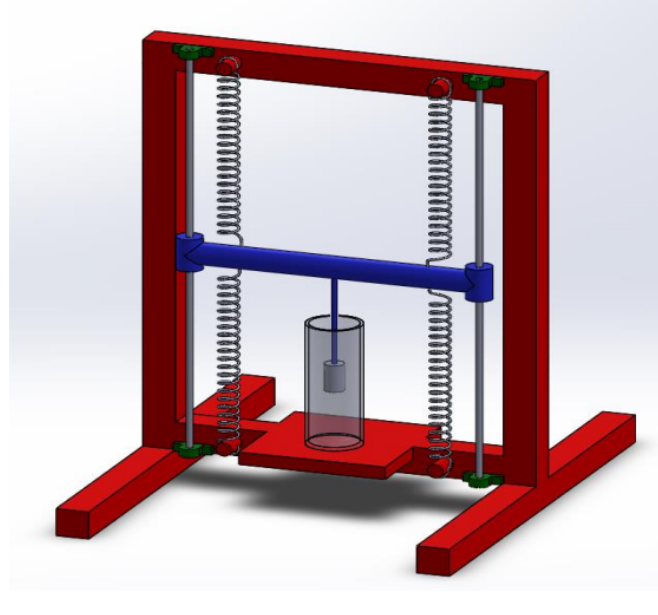
Have you ever thought about the energy hidden in the vibrations all around us? From the restless hum of wind to the rhythmic ebb of ocean waves, Harvesting Energy from Flow-Induced Vibration is not just a visionary concept now; it's a growing field of research that holds the promise of revolutionizing how we capture energy in a world of ever-increasing energy demand. In light of this exciting development, Kazi Fahrina Tabassum, Md. Jobayer Sazzad, Md. Jaeen Nur Aranya, Nabil Ahmed Rafi, and Md. Abdullah Al Ahad—under the expert guidance of Ms. Naznin Nahar, lecturer at the Department of Mechanical Engineering at AUST—showcased an innovative project on this very topic at the prestigious Mechanical Project Showcasing event at AUST. Let’s take a closer look at the methodology, results, and groundbreaking potential of their project!
How Can Flow-Induced Vibrations Generate Electricity?
Energy harvesting from flow-induced vibrations generates electricity by converting the mechanical energy of fluid flows (such as air, water, or other gases and liquids) into electrical energy. Utilizing natural phenomena like vortex shedding and galloping, it creates oscillations that drive a mechanism—often using electromagnetic induction—to produce an electric current. Thus, the project aims to create a sustainable energy source, particularly in wind or water environments.
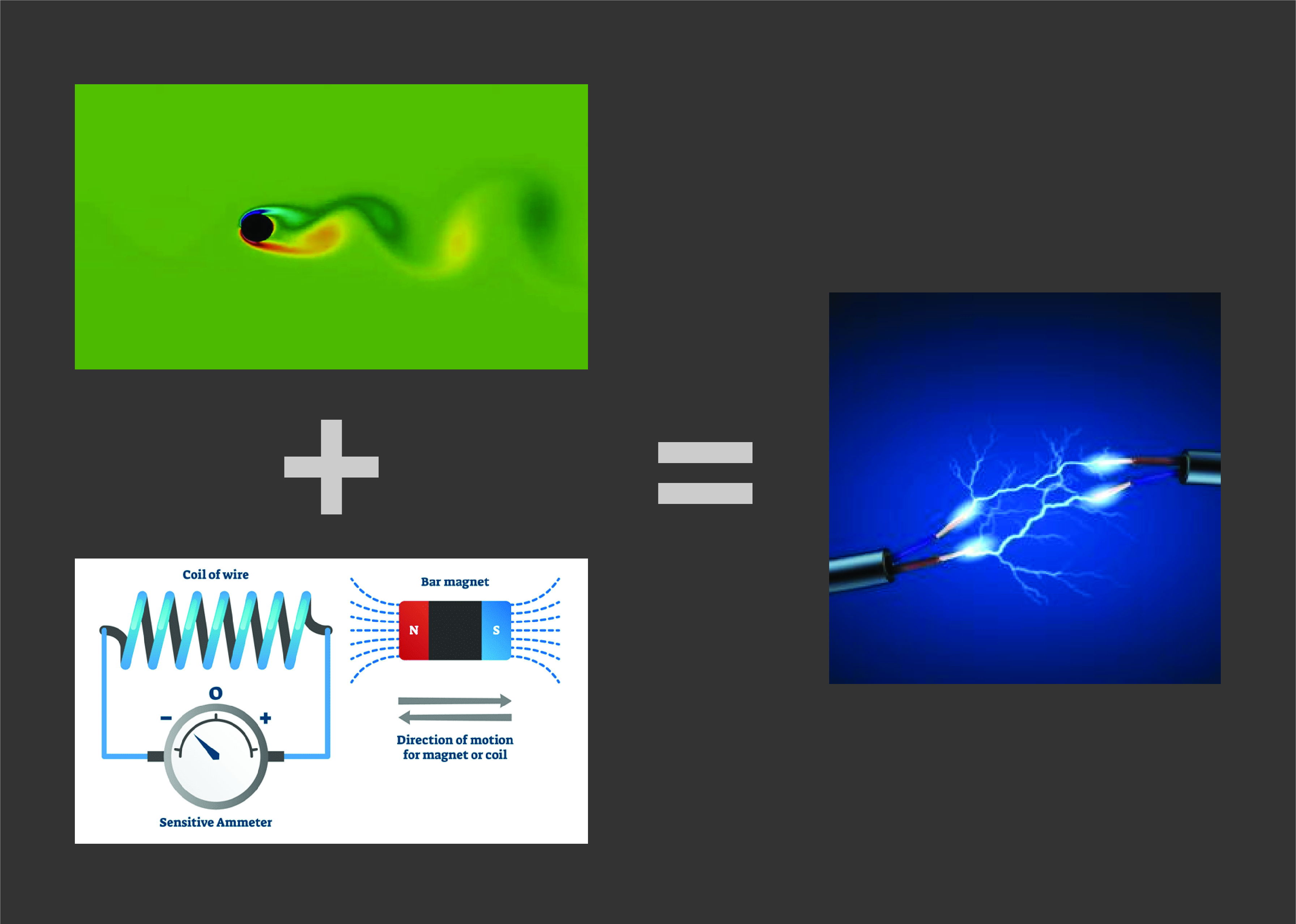
Terms to Understand
1) Vortex: occurs when fluid flows past a blunt object, causing alternating vortices to form on either side of the object. This results in periodic forces that induce oscillations in the object, which can be captured for energy conversion.
2) Galloping: is a dynamic instability occurring when fluid flows past a non-symmetric object. The resulting lift forces cause the object to vibrate transversely with increasing amplitude, also providing mechanical energy.
Equipment Required:
1. Mild steel frame
2. Stainless steel rod & rod clamp
3. Tension spring
4. N52 neodymium magnet
5. 36 gauge insulated copper wire
6. PVC pipe
7. Arduino Nano
8. Capacitors (100 µF)
9. 1N5819 Schottky Diodes
10. Voltage sensor
11. 16*2 LCD display
12. Different types of connector
Constructing the project:
Once the necessary equipment are collected, it’s time for construction and fabrication. This process can be divided into three parts:
1) Mechanical: The initial step involves constructing a frame from mild steel, which is securely welded together using arc welding techniques. A semi-cylindrical bluff body, with a cross-section shaped like the letter ‘D,’ is then 3D printed using PLA for its lightweight and cost-effective properties. Next, a neodymium magnet is attached perpendicularly to the bluff body, which is suspended in mid-air by four tension springs from the mild steel frame. This setup allows the bluff body, including the magnet, to oscillate freely.

2) Electrical: For the electrical setup, 0.5 kg of 36-gauge insulated copper wire is tightly wound around a PVC pipe to create a coil with 6000 turns, serving as the winding for the linear generator. This coil is strategically placed beneath the bluff body, ensuring the magnet remains centered both radially and longitudinally within the coil. The coil’s two ends are connected to a full bridge rectifier, converting the generated AC into DC. To monitor the output, a voltage sensor integrated with an Arduino measures the DC voltage, which is then displayed on an LCD screen.
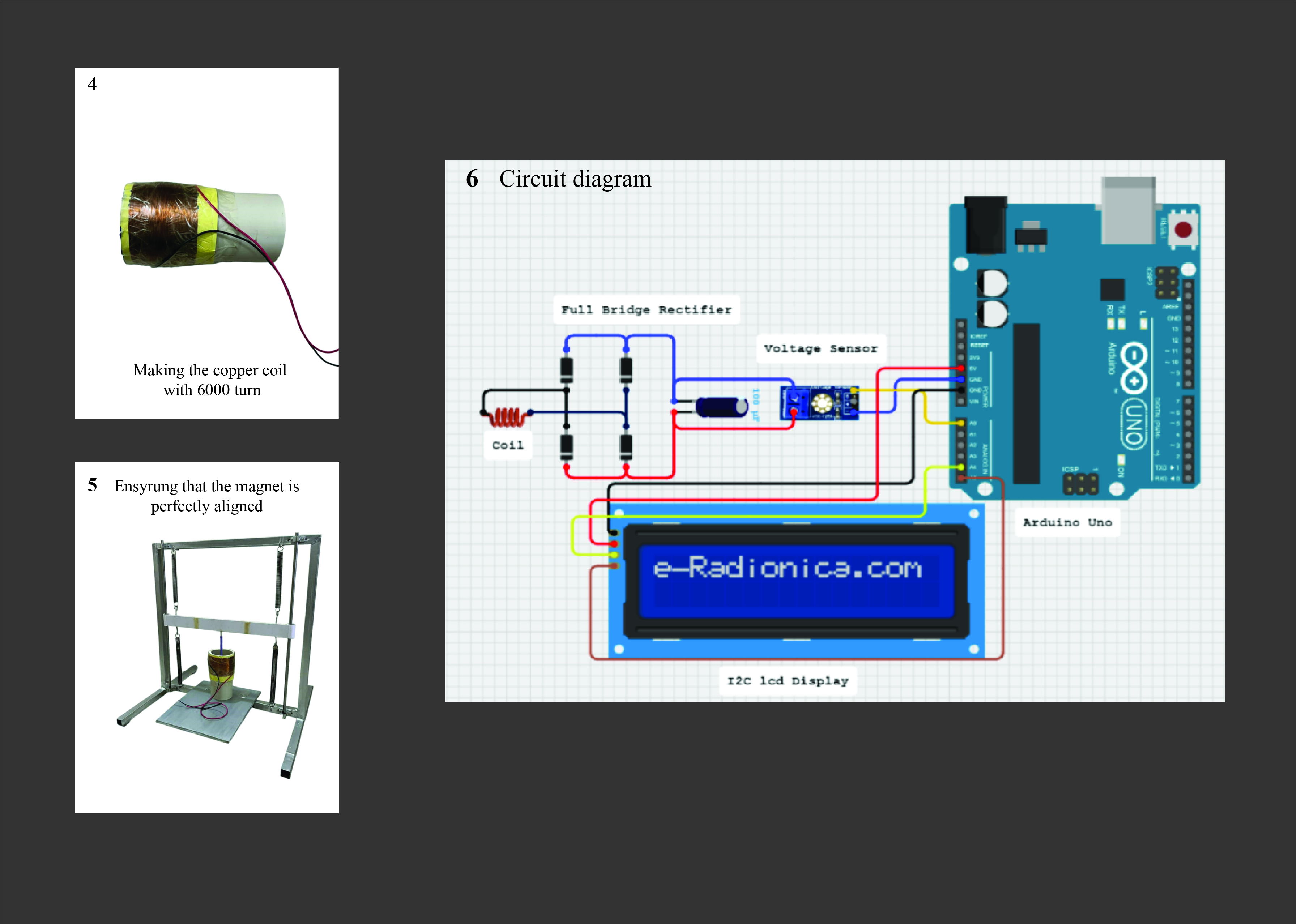
3) Coding: Here’s the program used for Arduino so that it can measure the voltage and display it on the screen.
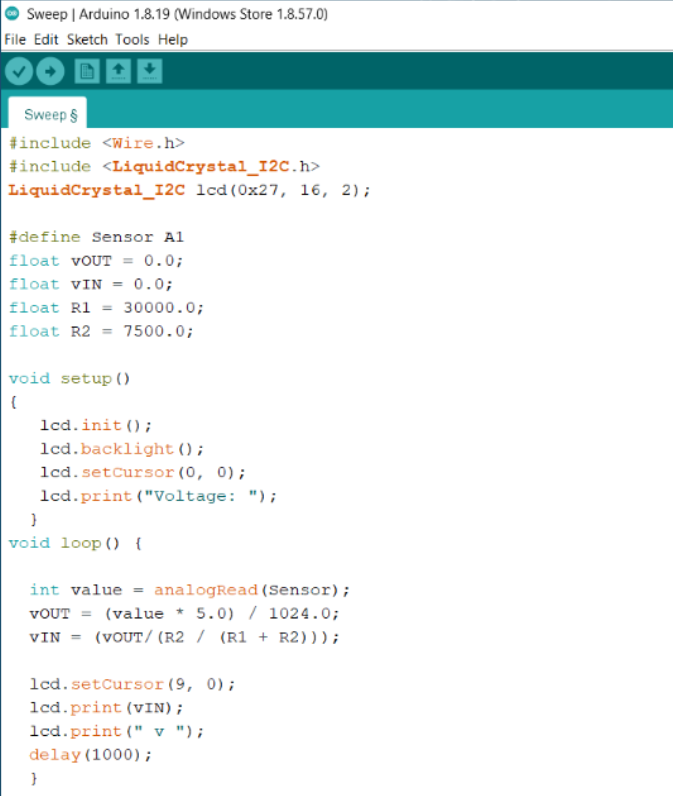
How does the device work?
After completing these three steps, a steady fluid flow was generated using a table fan. As the air flows over the bluff body (a white semi-circular cylinder), it creates small, regular oscillations due to the effect of vortex shedding. But on its own, these oscillations aren't strong enough to create large movements because the frequency of vortex shedding usually doesn't match the natural frequency of the system. However, the real boost comes from what's known as the galloping effect. Thanks to the specific shape of the bluff body, as it moves, the wind interacts in a way that increases the amplitude of its oscillations. The wind pushes the body up and down with each cycle, essentially amplifying the motion over time. Consequently, the magnet attached perpendicularly to the bluff body moves back and forth through the coil, cutting the magnetic field lines and finally inducing voltage!
Observations:
To observe how it works in real life, the device was tested at three different wind speeds of 2 m/s, 3 m/s, 4 m/s. For each of these speeds, data of real-time and voltage were recorded and plotted on the voltage against time graph shown below. From the graph, it can be seen that at every wind speed, the voltage rises with time and reaches a saturation point. As the velocity of the fluid increases, the voltage rises more quickly and reaches a higher saturation point within a shorter period of time.
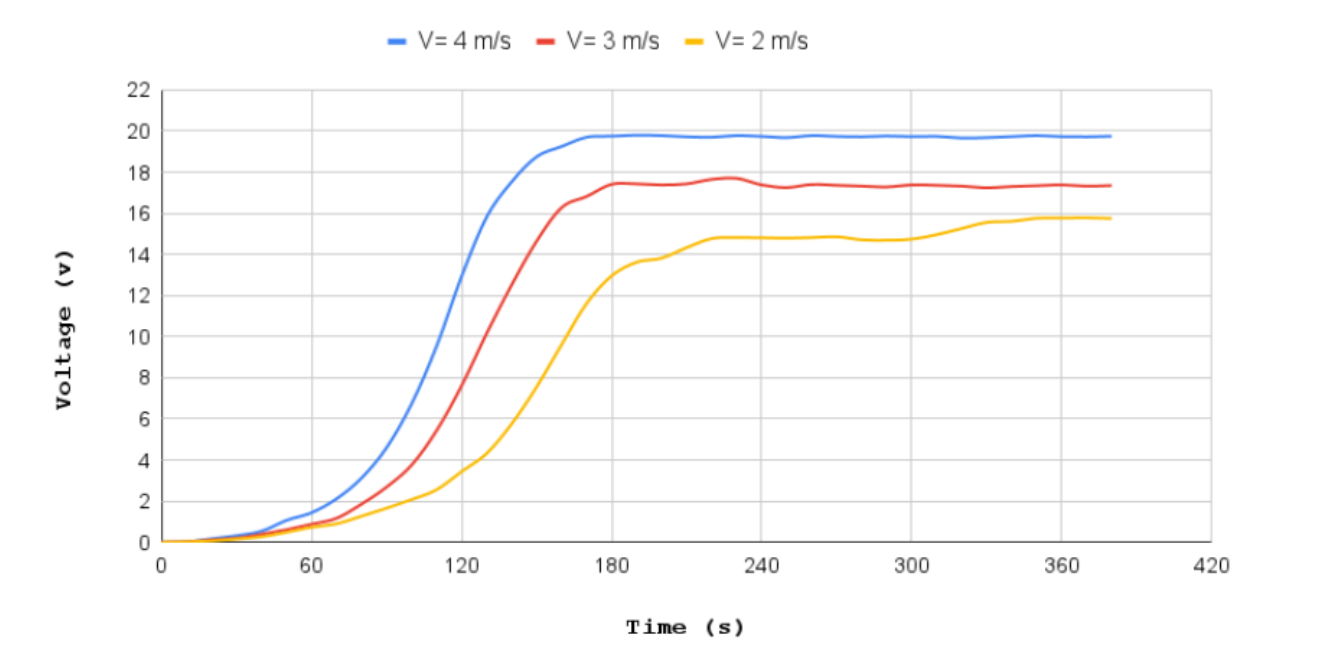
To measure the power output, the device is tested at three different wind speeds. A 2k ohm load is connected to the output, and the current flowing through the load, as well as the voltage across it, are measured using a multimeter. Once the current and voltage are recorded, the power is calculated by multiplying the two values, and the data is plotted on the bar graph below where it can be noticed that greater the speed of air, greater will be the power output.
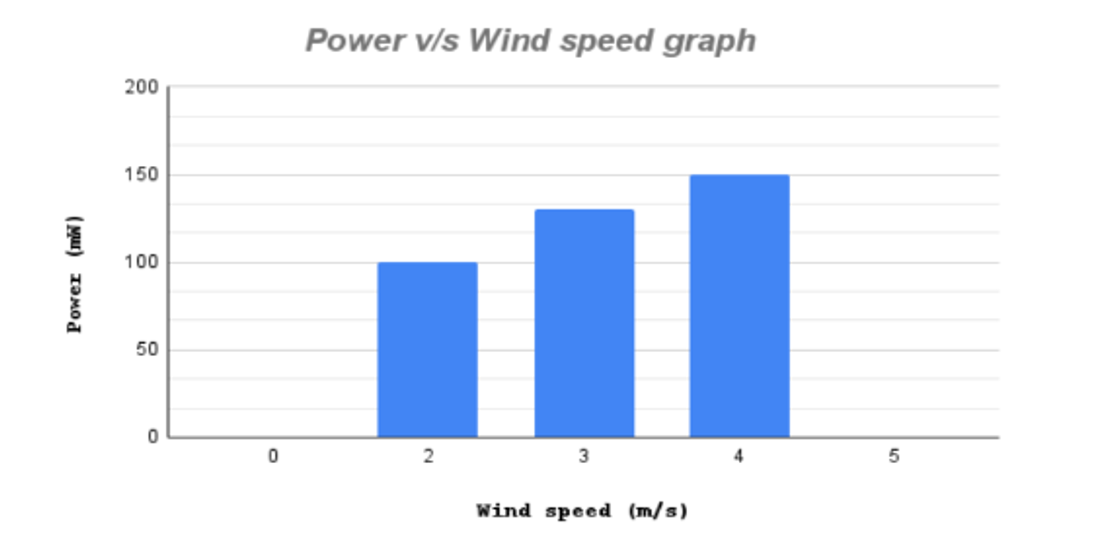
By analyzing these two graphs, a clear pattern emerges: as wind speed increases, both the voltage and power output rise significantly, with the device reaching maximum capacity more quickly. Furthermore, it demonstrates effective performance at both high and low wind speeds. Thus, it can be concluded that this device is well-suited for areas with low wind speeds.
Pros & Cons
This device offers a promising solution for harnessing renewable energy from fluid flows, making it suitable for various environments and applications. However, like any technology, it comes with its own set of advantages and limitations, which are important to consider for future improvements and practical implementations.
Advantages:
- Wide range of wind speed: This device can operate effectively at both high and low wind speeds, ensuring versatility in different climatic conditions.
- Works with various fluid flows: It functions not only with airflow but also with liquid flows such as water, making it adaptable to diverse energy sources.
- Sustainability: By harnessing renewable energy from fluid flow, the device reduces dependence on conventional power sources and contributes to a greener environment.
- Simple structure: Constructed from a steel frame, springs, and 3D-printed parts, the device has a simple and cost-effective design, making it easier to manufacture and maintain.
- Scalability: The device can be scaled up for larger systems or integrated into existing structures, such as bridges and buildings, for localized energy harvesting.
Disadvantages:
- Power limitations: While effective for low-power applications, the device’s output may not be sufficient for high-energy demands. However, future research and development could enhance its capacity for higher power output.
- Wear and tear: Continuous mechanical oscillations may cause material fatigue over time, leading to higher maintenance costs and potential downtime.
- Variable efficiency: The system's efficiency depends on the speed of the fluid flow and may fluctuate with changes in wind or fluid conditions, reducing its overall reliability and performance in unstable environments.
Future Potential
The future potential of energy harvesting from flow-induced vibrations is vast, with ongoing research expected to address the current limitations. Improvements in material durability and advanced tuning of the device's natural frequency could lead to higher power output and reduced wear and tear. Furthermore, integrating this technology into larger infrastructure, such as bridges, highways, or offshore platforms, holds the promise of providing localized energy solutions in remote or challenging environments. As the demand for renewable energy grows, this method could become a critical component of sustainable energy systems.
This innovative project highlights the untapped potential of flow-induced vibrations, transforming what was once considered mere noise into a viable source of renewable energy. As we continue to seek sustainable alternatives to meet growing energy demands, innovations like this one remind us that the answers may lie in the simple, often overlooked forces of nature. By pushing the boundaries of what's possible today, this technology could inspire the energy solutions of tomorrow—quietly yet powerfully shaping our future. Special thanks to Md. Jaeen Nur Aranya for providing valuable insights into this project, enabling us to share this groundbreaking knowledge with you. For a deeper dive into the working mechanism, feel free to reach out to us via the email address provided in the “Contact Us” section. Keep exploring!